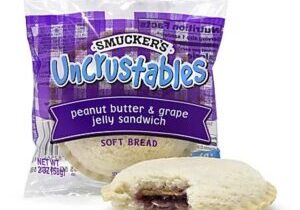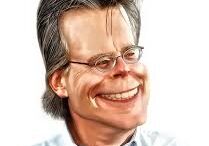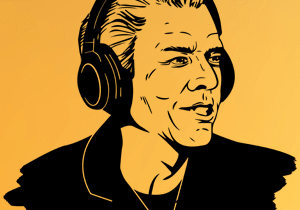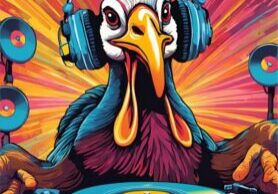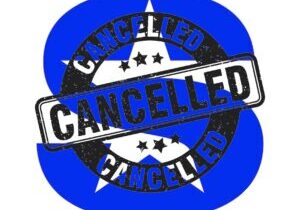
Photo: Lee Ann Jackson
Yesterday, I had the pleasure – and honor – to walk through a record-breaking crowd of broadcasters through the highlights of our 20th annual industry-wide research study, Techsurvey 2024. This year’s study – dubbed “Radio in the AI Era,” contained several new questions (yes, AI was included) about concert attendance and spending as well as perceptions vs. reality of how many Americans actually listen to broadcast radio during a typical week.
 And this year, I tried something a little different – letting you have a voice in what were the biggest findings in this year’s mega-survey. Channeling the late great Jack Palance and his wonderful “Curly” character (he won the Oscar for Best Supporting Actor for that portrayal) from the 1991 film, City Slickers, I asked our audience of webinar attendees to give me their take on the key takeaway from TS24. And thankfully, a number of you took me up on the offer. By the way, a sizable portion of observers this year included public and Christian broadcasters, in addition to vendors, consultants, and other interested parties.
And this year, I tried something a little different – letting you have a voice in what were the biggest findings in this year’s mega-survey. Channeling the late great Jack Palance and his wonderful “Curly” character (he won the Oscar for Best Supporting Actor for that portrayal) from the 1991 film, City Slickers, I asked our audience of webinar attendees to give me their take on the key takeaway from TS24. And thankfully, a number of you took me up on the offer. By the way, a sizable portion of observers this year included public and Christian broadcasters, in addition to vendors, consultants, and other interested parties.
In that film, by the way, the lead character played by Billy Crystal sold radio time for a living. The entire film revolved around his quest to find deeper meaning in his life. Just sayin’.
In today’s post, a unique look at what radio broadcasters think of the findings, and their implications on the industry. After sifting through the many responses that ended up in my email box yesterday, I’m wondering why I’d never done this before. It yielded a fascinating look at this study, including a special entry from a public radio broadcaster I’ll save until the end.
Jeremy Whiting – GM Impact-FM, Michigan State University
“The survey found that younger people – Millennials and Gen-Z – do most of their radio listening in cars. That lines up with what I see every day with college students. You’ll hear Spotify, podcasts, and music from other services in their earbuds linked from phones and laptops. In the car, it’s easier to keep the radio on rather than pairing music over Bluetooth or passing the aux.”
Fred comment: The attribute that the #1 reason why respondents say they listen to AM/FM radio is that it’s easier to listen to in cars. Spot on, Jeremy.
Mike Moore – PD WKHX, Cumulus, Atlanta
“The one thing that stuck out for me was radio’s impressive in car stats. However, I wonder how different those stats would look with a survey made up of the general public, rather than radio database participants?”
Fred comment: That’s often a differentiator, Mike. Check out Edison’s Share of Car where I do believe the AM/FM level is (as expected) lower than TS24. In many other areas, however, the match between the two studies is often close.
Milt McConnell – VP National & Group Sales, Alpha Media
“The one big thing for me was the shocking stats that showed that now radio listeners are actually underestimating the time spent with the medium. It is one thing to see the many studies over the last few years that show the great divide between what ad buyers think about the usage of radio and what the actual stats are…but it is a wake up call to see that reflected in the general population.”
Fred comment: That chart was an eye-opener for many people. The question was originally asked in TS20, and repeated in this year’s study. Perceptions of how many people listen to radio are even lower in this year’s study. And remember, these folks are radio fans.

Alan Burns – Alan Burns & Associates
“The most striking finding of Techsurvey 24 was that consumers think less than 60% of their counterparts listen to radio. That creates some peer pressure to say that they, too no longer listen. Advertisers fall prey to that kind of thinking, which makes it even harder to sell radio.
Our industry has done a terrible job of promoting itself. Fewer television spots and billboards for radio stations contribute to a decrease in top of mind awareness and sense that radio is “important.” We’ve got to do better.”
Fred comment: Falling below that 60% line is problematic and the fact perceptions are that SXM, Spotify, and podcasts have more reach than they do makes this data even more disturbing.
Dave Maurer – Retired PD & journalist
“The One Thing that stood out for me is the finding that 83% of those 45+ like the local feel and connection with personalities! Yet, radio companies continue to deemphasize experienced local talent in favor of entry level talent or go to more syndication. The research also shows that younger demos prefer local personalities, although they also are the group most likely to seek alternative delivery methods for music.
“I also was surprised by the dominance of Facebook across demos at a time we hear so much coverage of TikTok and other digital media platforms.”
Fred comment: The local piece – as you saw – is growing in importance since COVID. As for Facebook, it is amazing. But keep in mind our sample skews older.
Fleur Voruz – Senior Director, Media, Children’s Miracle Network Hospitals 
“Great Techsurvey presentation! I know I am only allowed one thing and I have two 😊
“I enjoyed hearing about fans’ interest in connecting with their favorite local talent and the ways other than on the radio. These connections are vital to the success of our partnership with radio stations.
“Secondarily, the number of smartphone and tablet owners who have downloaded radio apps being on an upward trajectory. Really an important data point in our distribution strategy.”
Fred comment: Paul and I work with Fleur and her team of media directors at CMN Hospitals on their amazing Radiothon fundraisers. The organization not only does amazing things, but they study our industry carefully to better understand how to best collaborate with radio.
Kipper McGee – Chief Brandwidth Strategist, Kipper McGee LLC
“As post-COVID tech innovation shifts music into a media commodity, the true standout is the monopoly of local personalities giving everything a relatable twist. Reporting the ongoing Music vs. Personality trend (out loud) is as clear and daring as Spengler and Venkman’s infamous proton stream crossing—risky, yet undeniably brilliant! Ironically, radio ownership seems hell-bent on slashing the very budgets that could capitalize on this massive opportunity. Fear not, Techsurvey 2024 isn’t just relevant; it’s ‘Taylor-Made’ for every audience!
‘On with the (local) show…”
Fred comment: Your podcast – along with David Martin – does a wonderful job of advancing many of these conversations. I’ve been honored to be your guest multiple times.
Ron Harrell – Consultant/Story Finder, Harrell Media Group
- Core radio listeners think Sirius/XM has a significantly larger audience than it does. Plus, they have a lower perception of AM/FM listening in America than is reported by ratings services.
- We know perception damage doesn’t happen overnight and isn’t repaired quickly.
- However, the radio community has to unite and market on the benefits of this medium: “Free,” “Personality,” “Community,” “Companionship,” etc.
- Here’s what is concerning about the perception of AM/FM listening. We’ve taken gut punches as an industry for a while. We’re Rocky Balboa sitting on the stool between rounds after Apollo Creed has pounded his face and Rocky can’t open his eye. Rocky tells his trainer, “Cut me, Mick.” Rocky comes out in the 15th Round and unleashes fury on Apollo.
- We know it’s been a hard 14 rounds. So does the audience. Do we have the reserve and the heart to come out slinging in the final round? It’s not about saving AM/FM. It’s about saving an Entertainment medium. There won’t be a need to migrate our content to apps and streams if we don’t give them a reason to want to listen.
- It starts by playing with a chip on our shoulder and cutting the eye. Then believing we can come out and pummel the champion.
Thanks for the engagement!”
Fred’s comment: After yesterday’s webinar, I feel a bit like I’ve been in a 14-round fight. I’m still punchin’.
Lee Ann Jackson – Social Media Manager/Media Strategist, The Ambassador Agency
“The need for stations to pay attention to what their audience wants to see in their overall car dash display as they more effectively plan their station’s metadata strategy.
“This was a ‘duh’ moment for me – just as web sites and then social media became valuable real estate for radio stations, now, stations are remiss to not leverage metadata as another point of contact with their audience. Utilizing metadata to message your station to your audience whether it be via sharing current song title/artist, emergency weather info, breaking news alerts, etc., is key given the captive car audience and the competing displays from other types of audio.”
Fred comment: And thanks for your artwork at the top of this post. Best to Peggy and Jim.
Tom Gjerdrum – Operations Manager, Midwest Communications
“Techsurvey 2024 did a great job of showing us that radio is still strong! The one thing that jumped out at me was the percentage of radio listeners who were very against AI DJs becoming a thing. Just when you think listeners aren’t paying attention – bam! They are!”
Fred’s comment: You’re correct on that, Tom. The data on AI is a waring from the audience. I expect their feelings may soften over time, but right now, it’s not an easy sell.
Joel Raab – President, Joel Raab Consulting
“The best news from your tech survey is that the bad news for radio is bottoming out, and in some improving in some analytics. The poor perception of radio listening vs. reality is eye opening. The NAB needs to have a marketing campaign for the ‘brand’ of radio.”
Fred’s comment: It makes sense, Joel, and it’s something we talked about in a recent post. After all these decades, we’ve told clients they need to be marketing, we need to take our own advice. Glad you could make it to the webinar.”
Bob Bellin – Radio GM/Market Manager
“Radio’s biggest fans are its youngest. This makes me think that if radio did a format that was focused on and really appealed to them, they might well come back. They’ve (18-44) figured out that there are often better places to hear music, but they really connect with the personalities and local perception. Maybe the 24-hour morning show idea makes sense for 18-44s. Certainly with more talk and features than is typical with more Boomer focused formats. They might also respond to a lot more high touch opportunities with personalities. Spoken word shouldn’t be overlooked when looking to reach 18-44s. Spending money for local talent might actually pay off – it’s what could be one of the building blocks of a younger focused station.”
Fred’s comment: Incisive as always. Sad that so little (or no) research has been conducted to understand Gen Z’s – who they are and what they want. It might not be as daunting a task as so many think. And not to worry, Bob, another Taylor Swift post is just around the corner.”
Paul Wells (aka The Lobster) – Co-Founder/President, Flow Communications
“Curly would be surly about this. My one thing is that it’s becoming rapidly more important to upgrade the quality of the digital audio feed to be consistent and competitive.”
Fred comment: That’s something few talk about – because few monitor their digital assets like they do their OTA product. As I am fond of saying, “Eat your own dog food.”
Don London – VP Operations/Programming, Audacy Virginia
“I vividly recall you saying ‘Radio had a play to better promote and remind its audience that it’s free and that it had value to the audience’ years ago during a Techsurvey presentation.
“I took that idea immediately and put it on the air on the five radio stations that I program for Audacy Virginia. We air these sweepers once every hour.
“I know most of our staff thought I was nuts back then. A few years later, the fact that radio is free is now essentially tied for the main reason people listen to the radio.”
Fred comment: Thanks for running with this, Don, and for sending the promo.
Erik Hanberg – Director of Audience Development, KNKX, Tacoma, WA
“My one big takeaway from the 2024 Tech Survey: “It’s free!” is a message that actually resonates with listeners and is getting stronger over time. The message is obvious to us in radio, but we shouldn’t forget that it’s not the norm anymore. No paywall, no subscription fee. You press a button and you get free news and music.
“As a public radio station, I want to think about how we can better incorporate this into our messaging, especially during fund drives. But maybe even in our marketing, too? “It’s free!” There’s a lot of power there.”
Fred’s comment: Erik, I deliberately placed your comment after Don London’s. There has to be a public radio strategy here.
Terry Troyet – Station Coordinator, WHFC, Bel Air, MD
“I found the strength of Facebook & Messenger data to be most interesting. Also, the use of QR codes. Question, has anyone developed a format targeted at Millennials or Gen-Z specifically?”
Fred’s comment: No, not really.
Jeff Winfield – Media Director of Programming, NRG
“First of all, thank you for doing your Techsurvey each year. It goes without saying that we live in interesting times, within our industry, and just in general! This is a thought I’ve had for a while, but the Techsurvey brought it top of mind again. Based on a Google search, there are over 15,000 commercial radio stations in the U.S. This number is more than double the number of 50 years ago. Yet today we’re faced with audio alternatives like satellite, podcasts, Spotify, Apple Music, YouTube and the list goes on and on. At the same time, companies continue to add HD channels & FM translator stations while at the same time outsourcing dayparts to syndicated shows, voicetrackers from a another market, or an internal voice who is already heard on a sister station.
“Isn’t it time to say there are too many radio stations? In any market you can go down the dial and find several stations that aren’t highly rated (by Nielsen or any other metric frankly), aren’t locally staffed, and serve virtually no community purpose whatsoever. I understand a flanker station and their strategic purpose competitively, but I’m talking about the stations that just sit in the rack in the tech room cranking out content that can be found several different places on demand.
“At what point do we thin the herd and stop fragging out the audience for that extra tenth of a share, and give space to the brands that DO have a robust audience, DO serve their communities, employ entertaining personalities, and DO make money?
“I ask this of you and your readers, how many stations could go away tomorrow and no one would care? I understand I’m over simplifying a complex question, but I’m curious to see what people think.
“There’s a positive Net Promoter score, and worse than that, the ‘I don’t think of (insert brand) at all!’”
Joel Denver – Former President/Publisher, All Access Music Group
“TS 2024 was a wonderful presentation my friend! truly the most comprehensive data presentation for the big look at what’s going on in radio across all platforms, digital, and evolving technologies like AI and how listener/user behavior is shifting.”
Fred’s comment: Joel, I miss being on the All Access Audio Summit stage presenting this data to your attendees – following Miss Benztown, of course. Seriously, you put on a great show in L.A., and the industry is missing this kind of gathering. Thanks for tuning into the webinar.
Dave Farough – Programming/Talent Development, VISTA Radio
“For me, the biggest A-ha was the average of radio P1s – now up to 56.7 (years-old) – and 62% are 55 plus! Wow.
“Either we launch younger formats to grow the bottom end…or we all move to classic formats. I’m hoping more younger formats are in the works, but I doubt it.”
Fred’s comment: It’s nice to get some “Canadian Content” in these comments, Dave. And yes, the early slide speaks volumes about where we are today as an industry.”
Norm McKee – Managing Partner/CFO, Local Media San Diego & Black Diamond Broadcasting
“Biggest takeaway for me is the perception of radio listening vs. the reality. This is where the industry has failed by taking a defensive posture, as opposed to an offensive one in promoting itself. We, as members of the industry, need to find a way to get the word out.
“Being on the business side of things, as well as an owner, I find this perception prevalent among bankers, private equity firms, etc. Hard for the industry to get a fair shake (financing acquisitions/growth) when the perception is so poor, combined with a few high profile business missteps recently.”
Fred comments: Norm, it’s a sad state of affairs when radio’s biggest fans discounts its impact.
Thank you for all these comments and observations. If you didn’t chime in above, use the comments option below to leave yours.
But one last opinion from a public media executive, Rima Deal (pictured below). The former GM of WSHU Radio in Fairfield, CT, Rima now heads up the National Federation of Community Broadcasters. Rima is a passionate fan of radio, but also a business person and a realist. Here’s what she had to say in response to TS24:
The Resilience of Radio: Connecting Through Music and Real Personalities – Rima Deal
For some of us in public radio, the past few weeks have been tough. The recent resignation of a veteran National Public Radio (NPR) editor who penned an essay alleging liberal bias in the network’s coverage has reignited demands from some congressional members to strip the federal government’s funding from the nonprofit media organization. If this every were to pass, this would definitely hurt the small radio stations I represent because the National Federation of Community Broadcasters (NFCB) pays NPR to assist our stations with their Sound Exchange reports which ensures compliance for copyright regulations. NFCB stations rely on NPR because of PRSS – Public Radio Satellite System (PRSS) to get many of our programs, not just from NPR but from American Public Media, Public Radio Exchange and others that distribute independent programs. And of course, we all rely on the PRSS for national public safety since it is an integral part of our Emergency Alert System. Additionally, the essay of the NPR editor conflated issues of a declining radio audience with a focus on DEI and community representation, which further allows anti-DEI sentiments to flourish in certain spaces. This is what is most personally exhausting for me and many folks of color in radio, who have to defend our rights to be in certain rooms, and the value of centering our narratives which have been historically marginalized. For all of the above reasons, it has been challenging these past few weeks.
reignited demands from some congressional members to strip the federal government’s funding from the nonprofit media organization. If this every were to pass, this would definitely hurt the small radio stations I represent because the National Federation of Community Broadcasters (NFCB) pays NPR to assist our stations with their Sound Exchange reports which ensures compliance for copyright regulations. NFCB stations rely on NPR because of PRSS – Public Radio Satellite System (PRSS) to get many of our programs, not just from NPR but from American Public Media, Public Radio Exchange and others that distribute independent programs. And of course, we all rely on the PRSS for national public safety since it is an integral part of our Emergency Alert System. Additionally, the essay of the NPR editor conflated issues of a declining radio audience with a focus on DEI and community representation, which further allows anti-DEI sentiments to flourish in certain spaces. This is what is most personally exhausting for me and many folks of color in radio, who have to defend our rights to be in certain rooms, and the value of centering our narratives which have been historically marginalized. For all of the above reasons, it has been challenging these past few weeks.
So, who would have thought that the balm for my soul would come from the Jacobs Media Techsurvey?!! An actually survey with data that presented me with facts over my own perception! Yes, the survey results and data presented by my friend Fred Jacobs centered on commercial radio, but there are a ton of public radio take-aways as well! The following are my reflections and musings from this calming survey, and you can download the report at Jacobs Media’s website: https://jacobsmedia.com/
In a world inundated with digital streaming services and AI-driven algorithms, radio continues to hold its ground as a significant medium for connecting people to music and real personalities. The recently published Jacobs Media Techsurvey 2024 report sheds light on the enduring appeal of radio, emphasizing that at its core, people tune in for the connections they feel with radio DJs and personalities; and music trumps all other formats.
One of the standout findings of the report is the strong preference for real human voices over AI personalities and algorithm-generated playlists. Listeners value the authenticity and spontaneity that radio hosts bring to the table, creating a sense of familiarity and connection that cannot be replicated by technology. This human touch serves as a unique selling point for radio in an increasingly digital landscape.
Passing the mic for a quick moment to a couple colleagues articulating the importance of connecting with community around music and the edge we can have in public and community radio:
Public media plays a crucial role in music discovery for communities around the world. The long legacy of trust that stations grow and nurture is fed by the dynamic and meaningful music we play. The vibrancy and diversity of programming, intentional relationships with the artists and their fans, and grassroots music movements creates and fosters a level of community engagement that is so rare and so special. I continue to applaud the work our community supported stations do to champion the creative community, enrich listening experiences, and provide gathering spaces for exploration and innovation.
Nikki Swarn, General Manager
89.3 KUVO & 104.7 THE DROP
Rocky Mountain Public Media
Public and community radio are also essential to many artists who rely on us to expose listeners to their music, be they local performers or nationally touring acts, emerging or established artists. Being heard on a public or community radio station (or at a station-sponsored concert) really matters to musicians, as well as concert venues across the country, large and small. And having a musician perform live on the radio is simply magical. I can’t imagine the field of music without public and community radio.
Matt Murphy, General Manager
89.9 FM – WERU Community Radio
One of the most intriguing takeaways from the Techsurvey report is the disparity between the perception of radio’s relevance and its actual listenership. Despite common beliefs about the decline of FM and AM radio, the data paints a different picture. A significant portion of the population still tunes in to traditional radio, underscoring its enduring popularity and influence. FM & AM radio outperforms listening to satellite radio and podcasts! (See the slide earlier in this presentation.)
As we reflect on these findings, it becomes apparent that radio’s strength lies in its ability to foster connections – connections between listeners and music, between listeners and radio personalities, and even between listeners and their vehicles. The medium continues to serve as a bridge that brings people together through shared experiences and shared love for music.
So, to all the skeptics and naysayers who underestimate the power of radio in the digital age, the Techsurvey report serves as a reality check. Radio is not just surviving; it is really doing okay – which means, we, those in radio, are doing okay. Thanks to its unique ability to provide a blend of music, companionship, and authenticity that resonates with audiences of all ages – again, Fred can share the data, this is important fact-based news. This is not a call to rest on our laurels – we must continue to innovate and connect with audiences of all ages. Yet, for today, let us appreciate the magic of radio for what it truly is – a timeless medium that keeps us connected in a fast-paced world.
Thank you Jacobs Media for a much-needed reality-check!
Please leave your comments below and thanks to all. – FJ
Originally published by Jacobs Media

